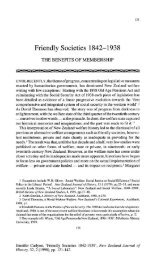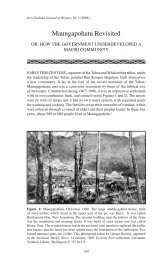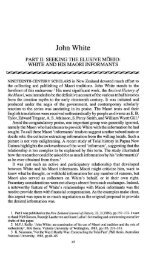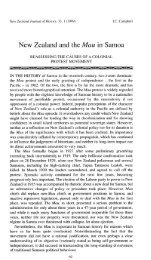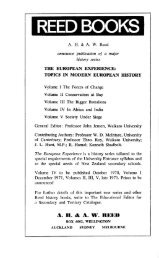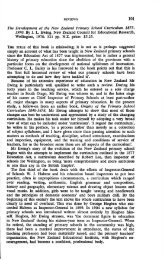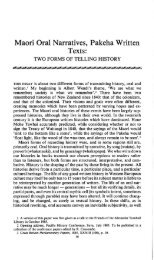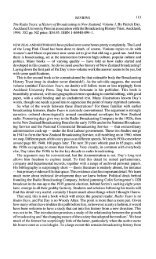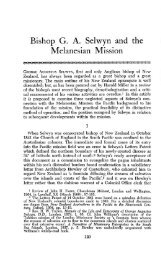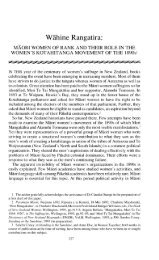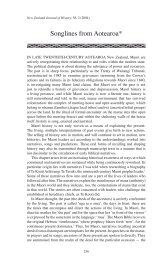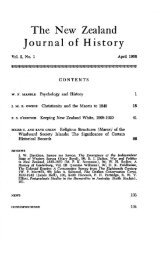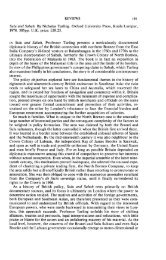Irish Migration to the West Coast, 1864-1900 - New Zealand Journal ...
Irish Migration to the West Coast, 1864-1900 - New Zealand Journal ...
Irish Migration to the West Coast, 1864-1900 - New Zealand Journal ...
You also want an ePaper? Increase the reach of your titles
YUMPU automatically turns print PDFs into web optimized ePapers that Google loves.
LYNDON FRASER<br />
assisted passengers selected from England, Wales, Ireland and Scotland<br />
according <strong>to</strong> each nationality's representation in <strong>the</strong> population of <strong>the</strong> United<br />
Kingdom. At <strong>the</strong> same time, <strong>the</strong>y made strenuous efforts <strong>to</strong> achieve <strong>the</strong><br />
Wakefieldian prescription for an even balance of <strong>the</strong> sexes by extending<br />
preferential terms <strong>to</strong> single women. 21 However, strong competition existed for<br />
migrant labour in Great Britain, and recruitment agents sent out substantial<br />
contingents of <strong>Irish</strong> passengers when o<strong>the</strong>r 'British' settlers were unavailable. 22<br />
This infusion of 'undesirables' provoked considerable anxiety in <strong>the</strong> colonies,<br />
where it sharpened anti-<strong>Irish</strong> sentiment and led <strong>to</strong> persistent complaints about<br />
<strong>the</strong> size and quality of <strong>the</strong> <strong>Irish</strong> intake. 23<br />
Almost one-third of a million <strong>Irish</strong> ventured <strong>to</strong> Australasia between 1840<br />
and 1914, along with 40,000-50,000 <strong>Irish</strong> felons transported in<strong>to</strong> penal exile in<br />
eastern Australia at imperial expense from 1788-1853. Relatively few elected<br />
<strong>to</strong> go <strong>to</strong> <strong>the</strong> colonies during <strong>the</strong> Great Famine, when more than one million<br />
people fled Ireland for safer havens abroad. 24 But <strong>the</strong> discovery of gold in 1851<br />
led <strong>to</strong> an influx of nearly 100,000 <strong>Irish</strong> migrants, doubling <strong>the</strong> number of arrivals<br />
between 1836 and 1850. 25 This spectacular increase continued in<strong>to</strong> <strong>the</strong> early<br />
1860s before it slowed temporarily, regaining momentum from <strong>the</strong> mid-1870s<br />
until <strong>the</strong> beginning of <strong>the</strong> next decade. Thereafter, <strong>the</strong> intensity of <strong>Irish</strong> movement<br />
<strong>to</strong> Australia slackened and became a relatively minor flow. 26 In global terms,<br />
<strong>the</strong> colonies accounted for about one-fourteenth of all <strong>the</strong> <strong>Irish</strong>-born people<br />
resident abroad in <strong>the</strong> later nineteenth century. Australian census returns from<br />
1891 show that more than two-thirds of <strong>the</strong> expatriates had settled in Vic<strong>to</strong>ria<br />
(37.6%) and <strong>New</strong> South Wales (33.1%), compared with about one-fifth in<br />
Queensland (19.0%). Much smaller numbers were resident in South Australia<br />
(6.3%), Tasmania (2.5%) and <strong>West</strong>ern Australia (1.5%). 27 <strong>Irish</strong> migrants<br />
constituted nearly one-quarter of <strong>the</strong> foreign-born component nationally in <strong>the</strong><br />
same year and were second only <strong>to</strong> <strong>the</strong> English-born as a source of Australia's<br />
immigrant population. 28<br />
<strong>Irish</strong> migration <strong>to</strong> <strong>the</strong> <strong>West</strong> <strong>Coast</strong> of <strong>New</strong> <strong>Zealand</strong>'s South Island differed in<br />
several crucial respects from <strong>the</strong> corresponding movement of free immigrants<br />
<strong>to</strong> <strong>the</strong> Australian colonies. In <strong>the</strong> first instance, <strong>the</strong> migrant stream contained an<br />
overwhelming preponderance of males throughout <strong>the</strong> nineteenth century. This<br />
was largely a consequence of timing, in that <strong>the</strong> gold rushes (1865-1868) <strong>to</strong>ok<br />
place concurrently with colonization and did not follow <strong>the</strong> introduction of<br />
agriculture or extensive pas<strong>to</strong>ralism as in <strong>New</strong> South Wales and Vic<strong>to</strong>ria. In<br />
addition, <strong>the</strong> region's main ecological modes of gold, coal and timber were<br />
extractive industries based on heavy manual labour. Taken as a whole, <strong>the</strong>se<br />
fac<strong>to</strong>rs militated against a balance of <strong>the</strong> sexes outside <strong>the</strong> major <strong>to</strong>wns and<br />
ensured that <strong>the</strong> <strong>West</strong> <strong>Coast</strong>'s <strong>Irish</strong>-born population retained a male imperium<br />
until well in<strong>to</strong> <strong>the</strong> twentieth century.<br />
An equally striking contrast with <strong>the</strong> <strong>Irish</strong>-Australian experience is that most<br />
newcomers were already seasoned colonials prior <strong>to</strong> <strong>the</strong>ir arrival and many had<br />
spent considerable periods in o<strong>the</strong>r <strong>New</strong> World settings. The extensive mobility<br />
of individual migrants is vividly illustrated in <strong>the</strong> case of Murtagh Doyle, a<br />
publican's son from Coolesholl, County Wexford, who emigrated <strong>to</strong> <strong>the</strong> state of<br />
<strong>New</strong> York and joined <strong>the</strong> US Army at Buffalo in 1857. When <strong>the</strong> American<br />
Civil War broke out in 1861, Doyle fought with <strong>the</strong> 8th Regiment of US Infantry



